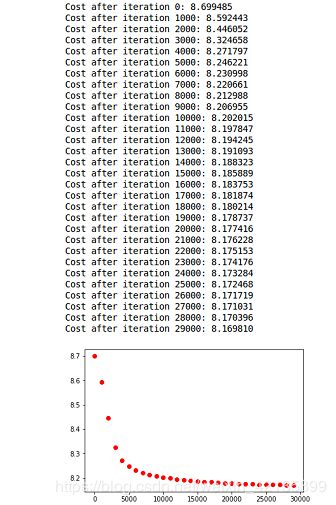超级简单的神经网络——训练数据分类(python语言)
需要kddtrain2018.txt和kddtest2018.txt的盆友,请下载我上传的资源:神经网络训练数据分类_kdd
内容:
根据给定数据集创建分类器。
训练数据集(kddtrain2018.txt):100 predictive attributes A1,A2,...,A100和一个类标C,每一个属性是介于0~1之间的浮点数,类标C有三个可能的{0,1,2},给定的数据文件有101列,6270行。
测试数据集(kddtest2018.txt):500行
处理过程:
1.将两个txt文件转换成excel,得到6270*101、500*100(test2018.xlsx)的两个.xlsx表格。
2.将训练文件6270*101分成两个表格:6000*101和270*101,得到train2018.xlsx文件和val2018.xlsx文件。
3.用train2018.xlsx代码训练
4.用val2018.xlsx验证,得到准确率96.7%
5.可以预测test结果,但是没有标签,所以不知道正确率......此步略:)
神经网络设计:
原则:简单点,写代码的方式简单点
三层网络,输入层,隐含层,输出层。
n_x=6000(6000个训练样本),n_h=32(32个神经元,也可以是别的数字),n_y=3(3类)
训练代码:
import numpy as np
import pandas as pd
import matplotlib.pyplot as plt
def initialize_parameters(n_x, n_h, n_y):
W1 = np.random.randn(n_h,n_x) * 0.01
b1 = np.zeros((n_h,1))
W2 = np.random.randn(n_y,n_h) * 0.01
b2 = np.zeros((n_y,1))
assert (W1.shape == (n_h, n_x))
assert (b1.shape == (n_h, 1))
assert (W2.shape == (n_y, n_h))
assert (b2.shape == (n_y, 1))
parameters = {"W1": W1,
"b1": b1,
"W2": W2,
"b2": b2}
return parameters
def forward_propagation(X, parameters):
W1 = parameters["W1"]
b1 = parameters["b1"]
W2 = parameters["W2"]
b2 = parameters["b2"]
# Implement Forward Propagation to calculate A2 (probabilities)
Z1 = np.dot(W1,X)+b1
A1 = np.tanh(Z1)
Z2 = np.dot(W2,A1)+b2
A2 = sigmoid(Z2)
#print(W2.shape)
#print(A2.shape)
cache = {"Z1": Z1,
"A1": A1,
"Z2": Z2,
"A2": A2}
return A2, cache
def compute_cost(A2, Y, parameters):
#计算损失时,用的是转换之后的标签
#m = Y.shape[1] # number of example
# Compute the cross-entropy cost
logprobs = -np.multiply(np.log(A2),Y)
cost = np.sum(logprobs)/A2.shape[1]
#print(logprobs.shape)
#print(cost.shape)
return cost
def backward_propagation(parameters, cache, X, Y):
#反向传播时,用的也是转换之后的标签Y->label_train
m = X.shape[1]
W1 = parameters["W1"]
W2 = parameters["W2"]
A1 = cache["A1"]
A2 = cache["A2"]
# Backward propagation: calculate dW1, db1, dW2, db2.
dZ2 = A2-Y
dW2 = np.dot(dZ2,A1.T)/m
db2 = np.sum(dZ2,axis=1,keepdims=True)/m
dZ1 = np.dot(W2.T,dZ2)*(1 - np.power(A1, 2))
dW1 = np.dot(dZ1,X.T)/m
db1 = np.sum(dZ1,axis=1,keepdims=True)/m
grads = {"dW1": dW1,
"db1": db1,
"dW2": dW2,
"db2": db2}
return grads
# GRADED FUNCTION: update_parameters
def update_parameters(parameters, grads, learning_rate = 1.2):
W1 = parameters["W1"]
b1 = parameters["b1"]
W2 = parameters["W2"]
b2 = parameters["b2"]
dW1 = grads["dW1"]
db1 = grads["db1"]
dW2 = grads["dW2"]
db2 = grads["db2"]
# Update rule for each parameter
W1 = W1-learning_rate*dW1
b1 = b1-learning_rate*db1
W2 = W2-learning_rate*dW2
b2 = b2-learning_rate*db2
parameters = {"W1": W1,
"b1": b1,
"W2": W2,
"b2": b2}
return parameters
#softmax函数定义
def softmax(x):
exp_scores = np.exp(x)
probs = exp_scores / np.sum(exp_scores, axis=1, keepdims=True)
return probs
def sigmoid(x):
s=1/(1+np.exp(-x))
return s
data = pd.read_excel('train2018.xlsx',header = None)
train = np.array(data)
X = train[:,0:100]
Y = train[:,100]
Y = Y.reshape((Y.shape[0],1))
#print(X.shape)
#print(X)
#print(Y.shape) # 1*6100
#print(Y)
X = X.T
Y = Y.T
n_x = X.shape[0]
n_h = 32
n_y = 3
parameters = initialize_parameters(n_x, n_h, n_y)
num_iterations = 30000
nuber = Y.shape[1]
label_train=np.zeros((3,nuber))
#根据Y值,转换分类标签,这里有三类输出:{0,1,2}
#Y为1*6100,转换之后为3*6000
for k in range(nuber):
if Y[0][k] == 0:
label_train[0][k] = 1
if Y[0][k] == 1:
label_train[1][k] = 1
if Y[0][k] == 2:
label_train[2][k] = 1
#label_train[int(Y[0][i])][i]=1
#print(label_train.shape)
#print(label_train)
for i in range(0, num_iterations):
learning_rate=0.05
#if i>1000:
# learning_rate=learning_rate*0.999
# Forward propagation. Inputs: "X, parameters". Outputs: "A2, cache".
A2, cache = forward_propagation(X, parameters)
pre_model = softmax(A2)
#pre_model = A2
# Cost function. Inputs: "A2, Y, parameters". Outputs: "cost".
cost = compute_cost(pre_model, label_train, parameters)
# Backpropagation. Inputs: "parameters, cache, X, Y". Outputs: "grads".
grads = backward_propagation(parameters, cache, X, label_train)
# Gradient descent parameter update. Inputs: "parameters, grads". Outputs: "parameters".
parameters = update_parameters(parameters, grads, learning_rate)
# Print the cost every 1000 iterations
if i % 1000 == 0:
print ("Cost after iteration %i: %f" %(i, cost))
plt.plot(i, cost, 'ro')训练结果:
验证代码:
data = pd.read_excel('val2018.xlsx',header = None)
test = np.array(data)
X_test = test[:,0:100]
Y_label = test[:,100]
Y_label = Y_label.reshape((Y_label.shape[0],1))
X_test = X_test.T
Y_label = Y_label.T
count = 0
a2,xxx=forward_propagation(X_test,parameters)
for j in range(Y_label.shape[1]):
#np.argmax返回最大值的索引
predict_value=np.argmax(a2[:,j])
#在val上计算准确度
if predict_value==int(Y_label[:,j]):
count=count+1
print(np.divide(count,Y_label.shape[1]))验证结果:
输出:0.9666666666666667
总结:
1.多分类与二分类的损失函数(交叉熵)不一样了!
2.交叉熵刻画的是两个概率分布之间的距离,但神经网络的输出不一定是概率分布,很多情况下是实数。Softmax可以将神经网络前向传播得到的结果变成概率分布。
3.要做分类,得有标签。K分类,标签为K*1维向量
参考:
详解numpy的argmax:https://blog.csdn.net/oHongHong/article/details/72772459
神经网络多分类任务的损失函数——交叉熵:https://blog.csdn.net/lvchunyang66/article/details/80076959
用python的numpy实现神经网络 实现手写数字识别:https://blog.csdn.net/weixin_39504048/article/details/79115437
